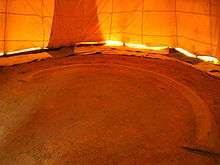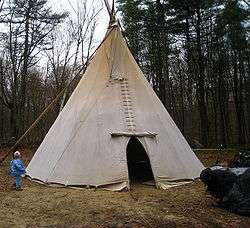Native American Church

| Part of a series on |
| Psychedelia |
|---|
|
The Native American Church (NAC), also known as Peyotism and Peyote Religion, is a Native American religion characterized by mixed traditional as well as Protestant beliefs and by sacramental use of the entheogen peyote. The religion originated in the U.S. state of Oklahoma in the late nineteenth century after peyote was introduced to the southern Great Plains from Mexico.[1][2][3] Today it is the most widespread indigenous religion among Native Americans in the United States, Canada, and Mexico, with an estimated 250,000 adherents as of the late twentieth century.[4][5][6][7]
History of the peyote religion



The religion probably originated among the Kiowa in Oklahoma about 1890 and reflects the influence of traditional peyote use among Mesoamerican groups such as the Huichol. In 1918 many peyotists were brought together as the Native American Church.
Development of the movement
Peyotism, or Peyote Religion, most widespread indigenous religious movement among North American Indians and one of the most influential forms of Pan-Indianism. The term peyote derives from the Nahuatl name peyotl for a cactus. The tops of the plants contain mescaline, an alkaloid drug that has hallucinogenic effects. It was used in Mexico in pre-Columbian times to induce supernatural visions and as a medicine.
From the mid-19th century, use of peyote extended north into the Great Plains of the United States, and probably first developed into a distinct religion about 1885 among the Kiowa and Comanche of Oklahoma. After 1891 it spread rapidly as far north as Canada and is now practiced among more than 50 tribes. Statistics are uncertain, but reports suggest nearly a fifth of the Navajo in 1951 practiced the peyote religion (despite strong tribal council opposition) as did one-third of Oklahoma Indians in 1965. The Native American Church claimed some 225,000 adherents in 1977.
The various forms of peyotist beliefs combine Indian and Christian elements in differing degrees. Among the Teton, for example, the Cross Fire group uses the Bible and sermons, which are rejected by the Half Moon followers, who, however, teach a similar Christian morality. In general, peyotist doctrine consists of belief in one supreme God (the Great Spirit), who deals with men through various spirits, which include the traditional waterbird or thunderbird spirits that carry prayers to God. In many tribes peyote itself is personified as Peyote Spirit, considered to be either God’s equivalent for the Indians to his Jesus for the whites, or Jesus himself. In some tribes Jesus is regarded as an Indian culture hero returned, as an intercessor with God, or as a guardian spirit who has turned to the Indians after being killed by the whites. Peyote, eaten in the ritual context, enables the individual to commune with God and the spirits (including those of the departed) in contemplation and vision and so to receive from them spiritual power, guidance, reproof, and healing.
Ceremony
The rite characteristically, but not always, takes place in a tepee around a crescent-shaped, earthen altar mound and a sacred fire. The all-night ceremony usually commences about 8 pm Saturday and is led by a peyote "chief." The services include prayer, singing, sacramental eating of peyote, water rites, and contemplation; they conclude with a communion breakfast on Sunday morning. The way of life is called the Peyote Road and enjoins brotherly love, family care, self-support through steady work, and avoidance of alcohol.
Roles
Roles within ceremonies include the Fireman, Drum Chief, and Cedar Chief. The Road Man, or Road Chief, is a title given to the leader of the peyote ceremony in the Native American Church.[8] Examples include, Truman Washington Dailey, Victor Griffin, and John Wilson.
History of persecution
Peyotism has had a history of persecution. Although peyote was banned by government agents in 1888 and later by 15 states, Congress, backed by the Bureau of Indian Affairs, the churches, and some Indian groups, resisted repeated attempts from 1916 to 1937 to have its use prohibited. In self-defense, peyote groups sought incorporation under state laws—first in Oklahoma as the First-born Church of Jesus Christ in 1914, then as the Native American Church in 1918, and by 1960 in some further 11 states. In the 1960s appeals by peyotists in the name of constitutional freedom of religion were supported by anthropologists and others and upheld in several state supreme courts.
See also
- Eagle-bone whistle
- Employment Division v. Smith
- Freedom of thought
- Hair drop, Native American Church regalia
- Indigenous peoples of the Americas
- The red road
References
- ↑ http://www.facstaff.bucknell.edu/jms089/Z-Unpublished%20Work/Shields-Christ%20&%20Cactus.pdf
- ↑ Catherine Beyer. "Peyote and the Native American Church". About.com Religion & Spirituality. Retrieved 5 March 2015.
- ↑ "Native American Church". Encyclopedia Britannica. Retrieved 5 March 2015.
- ↑ "Native American Church". Retrieved 5 March 2015.
- ↑ "World Religions & Spirituality - Native American Church". Retrieved 5 March 2015.
- ↑ "University of Virginia Library". Religiousmovements.lib.virginia.edu. 2006-09-07. Retrieved 2011-07-09.
- ↑ "'A Brief History of the Native American Church'". CSP. 1996.
- ↑ Fleming, Walter C. (2003). The Complete's Idiot's Guide to Native American History. Penguin Group. p. 282. ISBN 0-02-864469-7.
Bibliography
- Hayward, Robert. The Thirteenth Step: Ancient Solutions to the Contemporary Problems of Alcoholism and Addiction using the Timeless Wisdom of The Native American Church Ceremony. Native Son Publishers Inc., 2011. ISBN 0983638403. -- Describes the Native American Church Ceremony.
External links
| Wikimedia Commons has media related to Native American Church. |
- Listing of Native American Churches
- Native American Churches
- American Ethnography – The use of Peyote by the Carrizo and Lipan Apache tribes
- "Native American Church, Encyclopedia of the Great Plains
- Swan, Daniel C. (2009). "Native American Church". Encyclopedia of Oklahoma History and Culture. Oklahoma Historical Society.
- Cowger, Thomas W. (2009). "Pan-Indian Movements". Encyclopedia of Oklahoma History and Culture. Oklahoma Historical Society.